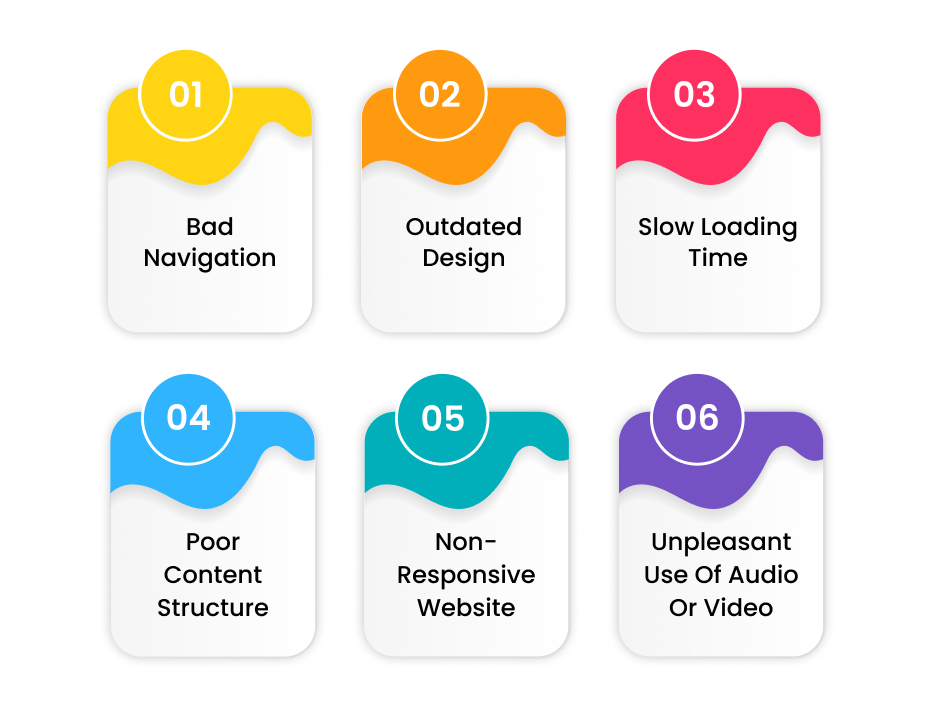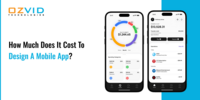- Mar 12, 2024
- Web Design
- 7676
Share this post on:

UX design refers to User Experience Design, a medium of seamless communication between users and brands. It is the process of offering products that give meaningful experiences to users. UX designs include all aspects of how an end user interacts with an application. This may include searching, browsing, purchasing items online, menu navigation, form filling, entering text, selecting links, page movement, etc.
UX design statistics show that 88% of visitors left the website after having a bad experience. What are the top reasons for a visitor to leave a website? Here are a few of them:
- Bad Navigation
- Outdated Design
- Slow Loading Time
- Poor Content Structure
- Non-Responsive Website
- Unpleasant use of Audio or Video

Hence, we cannot ignore the power of great UX designs. But how can you make intuitive and interactive designs that can get you more leads? How can you make great UX designs?
The key elements involved in UX Design
UX Design plays a critical role in modern technology industries. Understanding and improving the user experience is crucial for the success of any website or application. Good UX can increase engagement, reduce frustration, encourage loyalty, and benefit the bottom line.
User Experience Design includes various elements that create an effective and efficient user interface. Achieving good UX requires proper consideration of several components:

1. Strategy: Strategy helps in creating great user experiences. Solid strategies help businesses ensure all aspects of product development. It includes alignment with specific business goals, market conditions, target audience characteristics, industry dynamics, usability guidelines, and overall customer experience objectives. It provides direction and guidance throughout the entire design process.
A well-crafted strategy involves gathering information and addressing the pain points in a business. While you develop projects from the beginning or re-building a project, it helps you focus on what you are doing or the elements you need to focus on. Here are a few questions that a designer must try to get the answers at this stage.
- What is the goal of the product?
- How will this product benefit the company?
- Why would customers like this product?
- What are the problems faced by customers?
- How is this product different from what is already available in the market?
Further, taking calculated risks, balancing interests, and maintaining team discipline can lead to great designs that can offer positive changes in the business.
2. Scope: In this layer, designers decide what type of designs or content they want to design. Moreover, designers must be aware of the requirements and goals. There are two types of requirements:
- Functional Requirements: These requirements involve function and feature requirements that will add to the product.
- Content Requirements: These requirements involve themes, images, audio, and videos that will add value to the product.
Further, designers need to understand how to balance out requirements that will have a positive impact on the customers. Here are a few steps that can help you achieve the balance:
- Know the features clearly
- Explore the new experiences
- Constantly evolve and integrate
3. Structure: A well-structured user experience ensures that the users find it easy to navigate through the interface. The structure is where designers decide what type of design is needed and how to organize information. Also, they ensure to structure the information in a way that users can quickly locate what they need. Good organization makes the use of a site or application easy. This leads to higher engagement and satisfaction among visitors or clients, and the layer involves :
- Interaction Design: The design is developed as per the functional requirement of the product.
- Information Architecture: The architecture is built upon the content requirements and defines how to structure the content.
Ensure that Interaction Design and Information Architecture are well-structured. It creates a good relationship between people and the products by the following:
- Effectively communicates interactivity and functionality
- Develop simple and complex workflows
- Informs users about the state changes
- Prevent error
The following are the principle of Interactive Design:
- Maintaining consistency across interfaces and letting people use what they know
- Showcasing available opportunities increases interaction
- Learning becomes easy if the interface is well-defined
- Feedback enhances learning and helps in the improvement of designs
4. Skeleton: A skeleton refers to a basic layout or architecture of a website or application, also known as a wireframe. Skeleton outlines the placement of main elements like navigation menus, headers, footers, images, buttons, text fields, etc. It does not include detailed visual designs or specific styles and helps designers find the balance between the visual form and technical function. The following is the core principle of great UI designs:
- Depth
- Context
- Consistency
- Conventions
- Navigability
- Predictability
- Intuitiveness
- Information Hierarchy
- Progressive Disclosure
4. Surface: Surface elements in User Experience (UX) Design typically refer to those features that make up the visual aspect of a product. These include color schemes, typography, images, icons, graphics, and other forms of multimedia content that help communicate information and guide users through an interface.
These components work together to create an appealing visual hierarchy and form intending to enhance usability and user satisfaction. Ultimately, the implementation of surface elements should match the overall purpose of a given digital product, helping achieve goals efficiently and effectively for end-users.
The following is the basic principle of effective visual design:
- Organize: Offer users a clear and consistent conceptual structure.
- Economize: Ensure to represent the most information with the least number of visual cues.
- Communicate: Designs must present in a way that they communicate by themselves and matches the capabilities of users.
A few qualities to look for in a UX Designer
The field of User Experience (UX) design is constantly evolving, with new trends and best practices emerging every day.
A great user experience (UX) design creates a visually appealing appearance of products or websites and ensures to give users a smooth and enjoyable interaction process. It takes more than just technical skills to stay ahead of the competition.
Being a great UX designer involves having certain qualities that help you stand out. Here are some of the qualities of a great UX designer:

Problem-Solving: Problem-solving helps to become a great UX designer in several ways. It helps one become a great UX designer by using their ability to analyze and understand specific challenges. It enables them to create tailored solutions to address the issues and unlock benefits for individuals using their products. Also, it helps them understand user requirements and identify areas where improvements are needed.
By using different approaches, they can arrive at innovative solutions that meet both business objectives and provide exceptional user experiences.
User-centric Approach: Adopting a user-centered approach is essential for becoming a successful UX designer because it involves putting the users' needs first. The user-centered approach places users' expectations, behaviors, and needs at the center of every decision during the design phase. This creates systems and products that address their concerns and fulfill their needs.
The human-centered process enhances empathy for your audience. Through user research, you can gather crucial facts about the users' needs, behaviors, workflows, and constraints, empowering you to build your solutions from there. Here is how a user-centric approach helps designer:
- It helps them listen to the users more
- Keep the conversation open and detailed
- Handle users whose ideas do not align with you
- Validate other viewpoints and perspectives
Analytical Thinking: Analytical thinking plays a vital role in the success of UX designers and helps them understand complex data and identify patterns.
It breaks problems into manageable chunks, evaluates information, finds patterns, and narrows down the puzzles. Here are some reasons why analytical thinking plays a significant role in making a great UX designer:
- Data-Driven Decision-Making: Analytics provides valuable insights and when combined with research findings, helps shape the design process. Understanding patterns in user behavior and metrics can inform decisions around hierarchy, layout, and flow, thus creating more efficient UI design.
- Identifying Efficiency Improvements: The analytics can quickly bring attention to pain points within the user journey. The issues are solved through testing and analysis of data. This requires strong and critical reasoning abilities from the UX expert.
- Uncovering End User Needs: Using quantitative skills such as statistical analysis to discover unexpected trends can help designers build effective products used by satisfied customers.
Communication: Effective communication is crucial for a great UX designer. It allows designers to share their designs and ideas with team members effectively. Good communicators clearly articulate complex concepts both visually and verbally. They also know how to listen actively, read non-verbals effectively and ensure that their message entertains different audiences without losing clarity. Here are a few tips that can help you become a good designer.
- Listen actively to your customers
- Keep track of deadlines
- Be accountable and responsible
- Ask the right and meaningful questions
- Learn the art of storytelling
- Look for the common ground that can help you build a connection
Leadership: Great leadership qualities help one become a great UX Designer. Leadership involves coordinating between different teams and departments to ensure a smooth design process during and after launch. It helps designers lead multidisciplinary teams, manage projects, and influence decisions at strategic levels. Also, it allows designers to have a clear direction and purpose, influencing other parts of the enterprise.
Collaboration: Collaboration is vital for becoming a great UX Designer since creating excellent experiences. It includes collaboration with other designers, researchers, and developers. The best design solutions come from reviewing multiple perspectives aligned toward one goal.
Wrapping up:
Good UX design combines numerous elements that contribute to an effective user interface and meet the users' needs. Understanding and incorporating different aspects of UX designs leads to enjoyable and intuitive user experiences. It leads to increased satisfaction, usability, and conversions for business operations, respectively.
With dedication and effort, designers and developers can deliver remarkable user experiences that help them stand apart from competitors. If you are looking for the most reliable web designing services, look no further than OZVID Technologies.
We have a dedicated team of designers who have helped numerous businesses worldwide by developing the finest solutions for them. Schedule a meeting to learn more.











